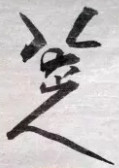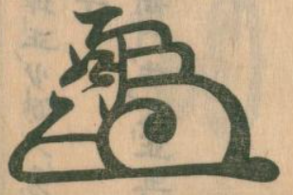Huaya
| Huaya | |||||||
|---|---|---|---|---|---|---|---|
 Kaō of Toyotomi Hideyoshi | |||||||
| Chinese name | |||||||
| Chinese | 花押 | ||||||
| |||||||
| Japanese name | |||||||
| Kanji | 花押 | ||||||
| Kana | かおう | ||||||
| |||||||
| Korean name | |||||||
| Hangul | 화압 | ||||||
| Hanja | 花押 | ||||||
| |||||||
A huaya ("Flower Print"; Chinese: 花押; pinyin: Huā Yā; Korean: 화압, romanized: Hwaap; Japanese: 花押, romanized: Kaō) is a stylized signature or mark used in East Asian cultures in place of a true signature. Originating from China, the huaya was historically used by prominent figures such as government officials, artists, and craftsmen. In modern times, they are still occasionally used by important people. Most huaya are constructed from parts of Chinese characters and resemble them to a certain degree, depending on the calligraphy style.
History[]
China[]
The oldest surviving record of huaya is in the Book of Northern Qi, the official history of the Northern Qi dynasty (550–577 AD).[1] Huaya reached its peak popularity during the Northern Song dynasty (960-1127).[2] After that, its popularity began to decline.

Mark of Emperor Xuanzong of Tang (685-762)

Mark of Emperor Taizu of Song (927-976)

Mark of Emperor Taizong of Song (939–997)

Mark of the Chongzhen Emperor (1611-1644)

Mark of the painter Bada Shanren (1626–1705)

Mark of general Li Hongzhang (1823-1901)
Japan[]
Huaya first spread to Japan during the Heian period (794-1185), where it is called kaō.[3] Though their use became far less widespread after the Edo period, they continue to be used even by some contemporary politicians and other famous people.[4] The reading and identification of individual kaō often requires specialist knowledge; whole books devoted to the topic have been published.[5]

Mark of Emperor Ōgimachi (1517-1593)
Mark of daimyo Uesugi Kenshin (1530-1578)

Mark of shogun Ashikaga Yoshiteru (1536-1565)

Mark of the noble Konoe Sakihisa (1536-1612)

Mark of shogun Tokugawa Ieyoshi (1793-1853)

Marks of members of the Council of Five Elders
See also[]
- Tughra, stylised Arabic signatures used by Ottoman sultans
- Khelrtva, stylised Georgian calligraphic signatures
- Signature
References[]
- ^ 李百药 (November 2020), 北齐书 [Book of Northern Qi] (in Chinese), 中国社会科学出版社, ISBN 978-7-5203-7496-5
- ^ "日本的"花押"到底是什么?" (in Chinese). June 6, 2020. Retrieved June 5, 2021.
- ^ 望月 鶴川 [Kakusen Mochizuki] (June 2005), 花押のせかい [The World of Kaō], 朝陽会 [Chōyōkai], ISBN 978-4-903059-03-7
- ^ 佐藤 進一 [Satō Shin'ichi] (September 2000), 花押を読む [Reading Kaō], 平凡社 [Heibonsha], ISBN 978-4-582-76367-6
- ^ 上島 有 [Tamotsu Kamishima] (December 2004), 中世花押の謎を解く―足利将軍家とその花押 [Cracking the Riddle of Kaō from the Middle Ages: The Ashikaga Shogunate and their Kaō], 山川出版社 [Yamakawa Shuppansha], ISBN 978-4-634-52330-2, JPNO 20717189
| Wikimedia Commons has media related to Kaō. |
- Writing system stubs
- Japan culture stubs
- Japanese culture
- Japanese calligraphy
- Authentication methods
- Identity documents
- Signature











